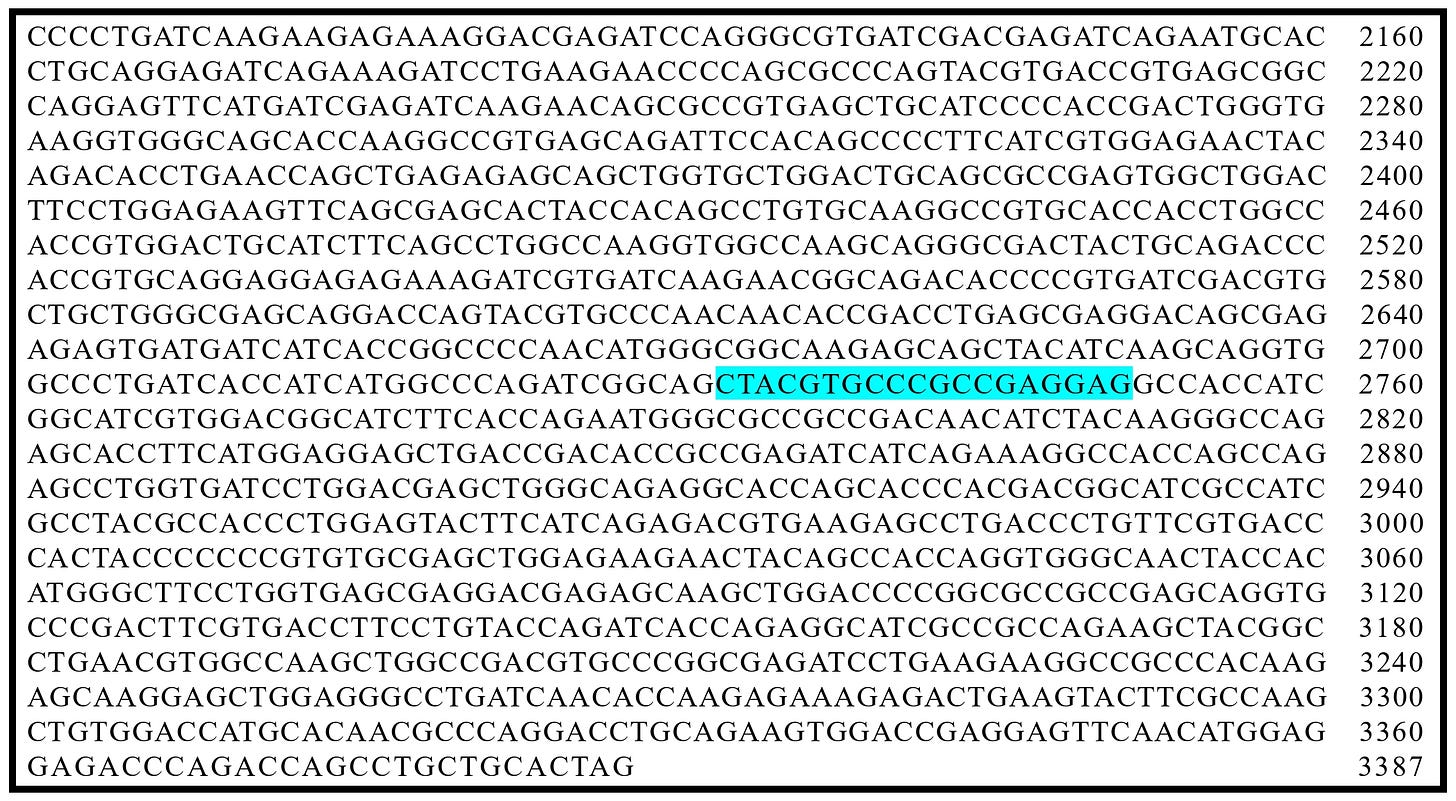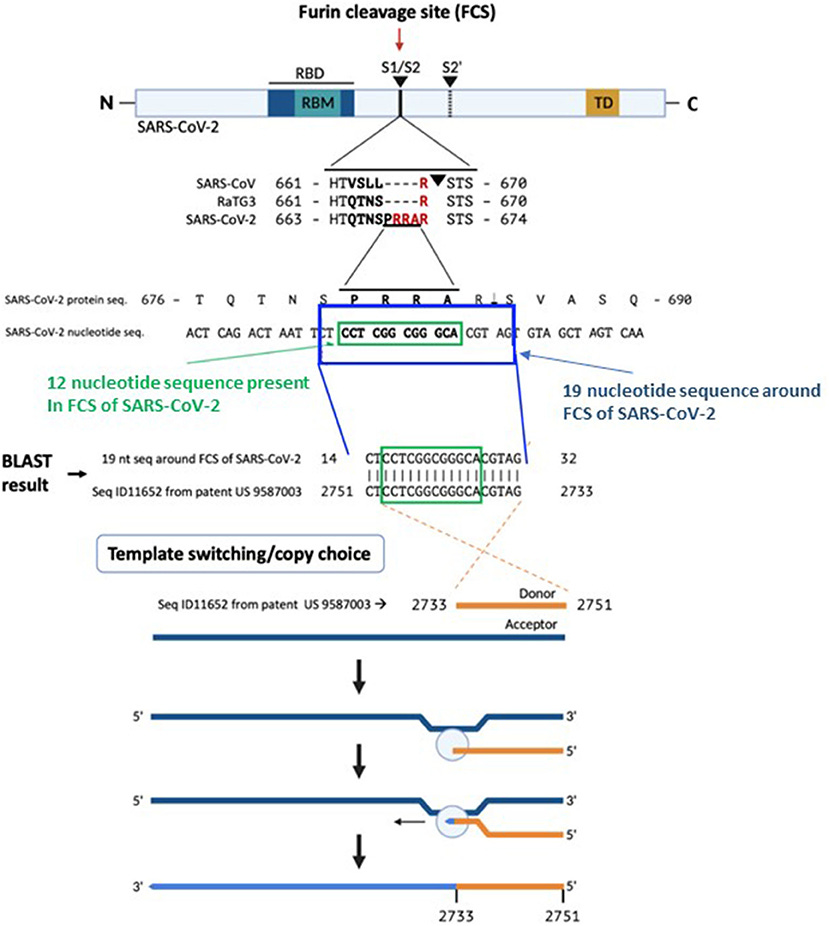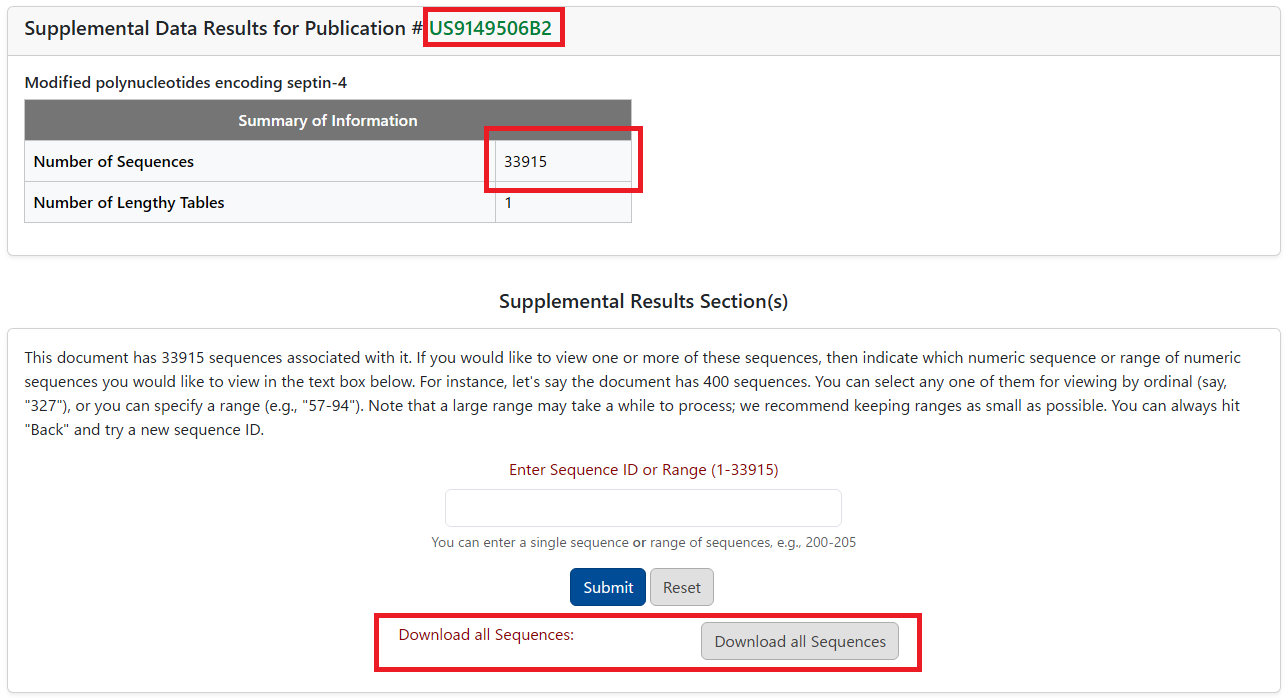I had posted about this topic on Twitter (see here), but I forgot to upload it here. I will now provide the enhanced content of the Twitter post from a patent perspective.
It is known that the COVID-19 virus includes the nucleotide sequence "CTCCTCGGCGGGCACGTAG" in its "Furin Cleavage Site," and that Moderna has the reverse complementary sequence of this in the Sequence Listing attached to their patent specification. The reverse complementary sequence to it is "CTACGTGCCCGCCGAGGAG."
MSH3 Homology and Potential Recombination Link to SARS-CoV-2 Furin Cleavage Site
It is said that the probability of the sequence "CTCCTCGGCGGGCACGTAG" naturally appearing in COVID-19 is to be "3e-11." There have been objections raised about this probability, but since it does not affect my post, I do not consider it important here. If there are perpetrators, their confessions will reveal everything, and thus in this context, discussing probabilities is meaningless. Rather, I would emphasize that we should give more consideration to the patents disclosures regarding this issue.
The following five Patents 1 to 5 (Patent Publications), each include the above reverse complementary sequence "CTACGTGCCCGCCGAGGAG" in their Sequence Listing.
However, no Patent rights have been granted for the reverse complementary sequence itself. Therefore, we must carefully explain this issue to avoid misleading the public.
Regarding the above Patents 1 to 5, by referring to the "We Claim" section (the scope of the claims) at the end of each specification, we can determine the scope of the patent rights.
As will be explained later, the SEQ ID containing "CTACGTGCCCGCCGAGGAG" is "SEQ ID 11652." As we can see in the "We Claim" section, there is neither a description for "SEQ ID 11652" nor for "CTACGTGCCCGCCGAGGAG."
From this fact, we can understand that the patent rights have been granted to different SEQ IDs, and patent rights have NOT been granted to the reverse complementary sequence.
Let's take a look at some more specific information about Patents 1 to 5.
Inventor: Tirtha Chakraborty, Antonin de Fougerolles
Title of invention: Modified polynucleotides encoding septin-4
Filing Date: December 16, 2013 (Priority to US14/107,079)
Registered date: October 6, 2015
"We Claim" section:
Inventor: Tirtha Chakraborty, Antonin de Fougerolles
Title of invention: Modified polynucleotides encoding granulysin
Filing Date: December 16, 2013 (Priority to US14/107,053)
Registered date: December 22, 2015
"We Claim" section:
Inventor: Tirtha Chakraborty, Antonin de Fougerolles
Title of invention: Modified polynucleotides encoding SIAH E3 ubiquitin protein ligase 1
Filing Date: December 16, 2013 (Priority to US14/107,105)
Registered date: February 9, 2016
"We Claim" section:
Inventor: Tirtha Chakraborty, Antonin de Fougerolles
Title of invention: Modified polynucleotides encoding apoptosis inducing factor 1
Filing Date: December 16, 2013 (Priority to US14/106,988)
Registered date: April 5, 2016
"We Claim" section:
Inventor: Stephane Bancel (CEO of Moderna), et al
Title of invention: Modified polynucleotides encoding apoptosis inducing factor 1
Filing Date: February 4, 2016 (Priority to US15/015,684)
Registered date: March 7, 2017
"We Claim" section:
In principle, the inventors of at least these five Patents 1 to 5 cannot claim that they were unaware of the MSH3. However, they could argue that they did not know how the MSH3 was used.
What is interesting here is that the lead inventor of the Patent 5, US9587003B2, is Stephane Bancel, the CEO of Moderna…
Next, I will explain how to obtain these Sequence Listings. The Sequence Listing cannot be obtained simply by obtaining the Patents 1 to 5.
How can we obtain and confirm the Sequence Listing?
We can access it by visiting the United States Patent Office website and entering any of the following patent numbers from the Patents 1 to 5. The Sequence Listing attached to the Patents 1 to 5 is the same. You can select and obtain any one of the SEQ IDs, or you can obtain all of the SEQ IDs.
Amazingly, this Sequence Listing contains 33,915 SEQ IDs, comprising a total of 1,431,049 lines. This is very ridiculous. The reverse complementary sequence "CTACGTGCCCGCCGAGGAG" can be found as part of "SEQ ID 11652." As we can see, this sequence merely forms a very small portion (only 19 bases) of the "SEQ ID 11652 (=MSH3)."
I have one question here. The filing dates of the four Patents 1 to 4 are all earlier than the filing date of the fifth Patent 5. However, these five Patents 1 to 5 share the same Sequence Listing. This means that it is possible that all the sequence data listed in the Sequence Listing attached to the Patents 1 to 5 were created by two persons, Tirtha Chakraborty and Antonin de Fougerolles, and it is highly likely that Stephane Bancel is not the inventor of the MSH3.
But could it really be that these 33,915 SEQ IDs were created by just those two individuals? Even if they created one SEQ per day, it would take nearly 93 years. If they created 10 SEQs per day, it would still take 9 years. Only by creating 100 SEQs per day could they complete it in a year. I think this seems too unrealistic.
One possibility here is that the SEQ IDs attached to multiple earlier patent applications were copied and pasted into the Sequence Listing of these five Patents 1 to 5. In this case, the sequence of the problematic MSH3 could be attached to even earlier patent applications.
Another possibility here is that Moderna comprehensively disclosed the work products of its employees. In this case, nucleotide sequences that are not intended for patenting would be disclosed solely for the purpose of publication. These sequences would serve as defensive elements, functioning as barriers to prevent other companies from obtaining patents. Additionally, it would also encourage third-party utilization.
In this context, it makes sense that SEQ ID 11652 is not mentioned in the patent specifications and is not listed in the "We Claim" sections.
Just to be sure, I conducted a simple patent search for the MSH3, but I was unable to find anything. Is it possible to perform a reverse patent search using the MSH3 sequence?
Since I do not have expertise in patent searches involving nucleotide sequences, I would appreciate it if anyone with information on other patents related to the MSH3 or any relevant details could contact me.
The topic has strayed off course, but realistically, it is not possible for Moderna to obtain a patent for this specific sequence, "CTACGTGCCCGCCGAGGAG," or just a part of it (i.e., the furin cleavage site). This is because Moderna disclosed "SEQ ID 11652" as a complete sequence, which includes that specific sequence, but did not disclose the segment as an independent invention. This fails to meet the support requirement for patentability, and it is unlikely that a patent will be granted for this specific sequence in the future.
Furthermore, even if Moderna were to attempt to obtain a patent right for "SEQ ID 11652," I believe it would be a difficult process. Realistically, if Moderna were to pursue a patent right for "SEQ ID 11652," the specification would need to explicitly describe the usage, function, and effects of "SEQ ID 11652" in order to meet the aforementioned support requirement. However, none of the specifications in the Patents 1 to 5 mention "SEQ ID 11652," nor is there any disclosure suggesting it.
Additionally, Moderna does not address the complementary sequence of "CTACGTGCCCGCCGAGGAG," which is "CTCCTCGGCGGGCACGTAG," anywhere in the specification. Therefore, the patent rights of the Patents 1 to 5 never extend to the 'CTCCTCGGCGGGCACGTAG' sequence of the COVID-19 virus.
Personally, I think this is the most concerning aspect of the Patents 1 to 5. It is because when focusing solely on these Patents 1 to 5, a realistic issue arises where a mad scientist might be forced to extract the problematic 19-base sequence from the "33,915 SEQ IDs." In other words, the concern isn’t that Moderna has obtained the patent, but rather the real fear that arises from the fact that Moderna has not.
Assuming that the mad scientist attempts to integrate "CTCCTCGGCGGGCACGTAG" into a progenitor virus of COVID-19 with no prior knowledge, it would not be sufficient for the mad scientist to simply read the Patents 1 to 5 as I explained above. The mad scientist has to undergo many steps…
First of all, the mad scientist must access the Sequence Listing, which can be obtained from the United States Patent Office website.
Next, the mad scientist must examine each of the "33,915 SEQ IDs" one by one and study their detailed functions. At this point, a sequence map for each sequence would also be required.
Then, the mad scientist must identify the reverse complementary sequence "CTCCTCGGCGGGCACGTAG" within "SEQ ID 11652."
Afterward, the mad scientist must reverse it to "CTACGTGCCCGCCGAGGAG" in order to incorporate it into the progenitor virus of COVID-19.
Generally, to avoid patent disputes, companies typically refer to the scope of the patented claims. However, with regard to the Patents 1 to 5, there is no patent right for "SEQ ID 11652" or the target sequences, and therefore, there is no motivation for us, as ordinary individuals, to focus on them in the first place.
Did the mad scientist overcome such obstacles in their daily work and confirm the "33,915 SEQ IDs" one by one?
Imagine:
Can you do this?
How long would it take?
Why does the mad scientist need to access this sequence listing?
Where does the motivation for the mad scientist come from?
The questions are endless…
Considering these circumstances, it must be said that the knowledge of the mad scientist far exceeds that of an ordinary scientist. It is therefore rational to suspect that the mad scientist had prior knowledge of the reverse complementary sequence.
As a matter of course, if the reverse complementary sequence had been reported separately in a paper or elsewhere, it might have been easier to integrate it into the progenitor virus of COVID-19. Also, it is possible that this is just a coincidence. In that case, I sympathize deeply with Moderna for the unfortunate accident.
To understand this issue more, we also need to deeply study the function of "SEQ ID 11652." "SEQ ID 11652" encodes the "MSH3," a mismatch repair factor involved in DNA repair. If cells expressing the "MSH3" are infected by a virus, the error repair mechanism may be affected, and mutations could accumulate. This can occur, especially when the virus interferes with the host cell’s repair mechanisms. Therefore, if the "MSH3" and the ancestral COVID-19 virus are present together, there may be a possibility that the virus’s mutations accelerate.
Since "CTCCTCGGCGGGCACGTAG" contains the reverse complement sequence of the "Furin Cleavage Site," it should not have the function of the "Furin Cleavage Site." The "Furin Cleavage Site" typically includes a specific sequence for recognition by the Furin protease, so the reverse complement sequence may interfere with the necessary recognition or cleavage function.
In this context, it is important to focus on the technical reasons for the presence of "CTCCTCGGCGGGCACGTAG" in the MSH3. Please think deeply about the following question:
Why does Moderna MSH3 contain "CTCCTCGGCGGGCACGTAG"?
What is the technical significance of Moderna MSH3 containing "CTCCTCGGCGGGCACGTAG"?
What would happen if this sequence were absent from the MSH3?
Is the function of that sequence in the MSH3 the same as the function of the COVID-19 sequence (i.e., the furin cleavage site)?
We must specifically consider the reason for the presence of this sequence from the functional perspective of the MSH3. In other words, if a clear purpose for the presence of that sequence in the MSH3 cannot be found, we need to consider why that sequence exists there. By considering these aspects comprehensively, we may be able to approach this issue from a different perspective.
FYI:
<210> SEQ ID NO 11652/33915 (Mismatch Repair: MSH3)
<211> LENGTH: 3387
<212> TYPE: DNA
ATGAGCAGAAGAAAGCCCGCCAGCGGCGGCCTGGCCGCCAGCAGCAGCGCCCCCGCCAGACAGGCCGTGCTGAGCAGATTCTTCCAGAGCACCGGCAGCCTGAAGAGCACCAGCAGCAGCACCGGCGCCGCCGACCAGGTGGACCCCGGCGCCGCCGCCGCCGCCGCCCCCCCCGCCCCCGCCTTCCCCCCCCAGCTGCCCCCCCACATCGCCACCGAGATCGACAGAAGAAAGAAGAGACCCCTGGAGAACGACGGCCCCGTGAAGAAGAAGGTGAAGAAGGTGCAGCAGAAGGAGGGCGGCAGCGACCTGGGCATGAGCGGCAACAGCGAGCCCAAGAAGTGCCTGAGAACCAGAAACGTGAGCAAGAGCCTGGAGAAGCTGAAGGAGTTCTGCTGCGACAGCGCCCTGCCCCAGAGCAGAGTGCAGACCGAGAGCCTGCAGGAGAGATTCGCCGTGCTGCCCAAGTGCACCGACTTCGACGACATCAGCCTGCTGCACGCCAAGAACGCCGTGAGCAGCGAGGACAGCAAGAGACAGATCAACCAGAAGGACACCACCCTGTTCGACCTGAGCCAGTTCGGCAGCAGCAACACCAGCCACGAGAACCTGCAGAAGACCGCCAGCAAGAGCGCCAACAAGAGAAGCAAGAGCATCTACACCCCCCTGGAGCTGCAGTACATCGAGATGAAGCAGCAGCACAAGGACGCCGTGCTGTGCGTGGAGTGCGGCTACAAGTACAGATTCTTCGGCGAGGACGCCGAGATCGCCGCCAGAGAGCTGAACATCTACTGCCACCTGGACCACAACTTCATGACCGCCAGCATCCCCACCCACAGACTGTTCGTGCACGTGAGAAGACTGGTGGCCAAGGGCTACAAGGTGGGCGTGGTGAAGCAGACCGAGACCGCCGCCCTGAAGGCCATCGGCGACAACAGAAGCAGCCTGTTCAGCAGAAAGCTGACCGCCCTGTACACCAAGAGCACCCTGATCGGCGAGGACGTGAACCCCCTGATCAAGCTGGACGACGCCGTGAACGTGGACGAGATCATGACCGACACCAGCACCAGCTACCTGCTGTGCATCAGCGAGAACAAGGAGAACGTGAGAGACAAGAAGAAGGGCAACATCTTCATCGGCATCGTGGGCGTGCAGCCCGCCACCGGCGAGGTGGTGTTCGACAGCTTCCAGGACAGCGCCAGCAGAAGCGAGCTGGAGACCAGAATGAGCAGCCTGCAGCCCGTGGAGCTGCTGCTGCCCAGCGCCCTGAGCGAGCAGACCGAGGCCCTGATCCACAGAGCCACCAGCGTGAGCGTGCAGGACGACAGAATCAGAGTGGAGAGAATGGACAACATCTACTTCGAGTACAGCCACGCCTTCCAGGCCGTGACCGAGTTCTACGCCAAGGACACCGTGGACATCAAGGGCAGCCAGATCATCAGCGGCATCGTGAACCTGGAGAAGCCCGTGATCTGCAGCCTGGCCGCCATCATCAAGTACCTGAAGGAGTTCAACCTGGAGAAGATGCTGAGCAAGCCCGAGAACTTCAAGCAGCTGAGCAGCAAGATGGAGTTCATGACCATCAACGGCACCACCCTGAGAAACCTGGAGATCCTGCAGAACCAGACCGACATGAAGACCAAGGGCAGCCTGCTGTGGGTGCTGGACCACACCAAGACCAGCTTCGGCAGAAGAAAGCTGAAGAAGTGGGTGACCCAGCCCCTGCTGAAGCTGAGAGAGATCAACGCCAGACTGGACGCCGTGAGCGAGGTGCTGCACAGCGAGAGCAGCGTGTTCGGCCAGATCGAGAACCACCTGAGAAAGCTGCCCGACATCGAGAGAGGCCTGTGCAGCATCTACCACAAGAAGTGCAGCACCCAGGAGTTCTTCCTGATCGTGAAGACCCTGTACCACCTGAAGAGCGAGTTCCAGGCCATCATCCCCGCCGTGAACAGCCACATCCAGAGCGACCTGCTGAGAACCGTGATCCTGGAGATCCCCGAGCTGCTGAGCCCCGTGGAGCACTACCTGAAGATCCTGAACGAGCAGGCCGCCAAGGTGGGCGACAAGACCGAGCTGTTCAAGGACCTGAGCGACTTCCCCCTGATCAAGAAGAGAAAGGACGAGATCCAGGGCGTGATCGACGAGATCAGAATGCACCTGCAGGAGATCAGAAAGATCCTGAAGAACCCCAGCGCCCAGTACGTGACCGTGAGCGGCCAGGAGTTCATGATCGAGATCAAGAACAGCGCCGTGAGCTGCATCCCCACCGACTGGGTGAAGGTGGGCAGCACCAAGGCCGTGAGCAGATTCCACAGCCCCTTCATCGTGGAGAACTACAGACACCTGAACCAGCTGAGAGAGCAGCTGGTGCTGGACTGCAGCGCCGAGTGGCTGGACTTCCTGGAGAAGTTCAGCGAGCACTACCACAGCCTGTGCAAGGCCGTGCACCACCTGGCCACCGTGGACTGCATCTTCAGCCTGGCCAAGGTGGCCAAGCAGGGCGACTACTGCAGACCCACCGTGCAGGAGGAGAGAAAGATCGTGATCAAGAACGGCAGACACCCCGTGATCGACGTGCTGCTGGGCGAGCAGGACCAGTACGTGCCCAACAACACCGACCTGAGCGAGGACAGCGAGAGAGTGATGATCATCACCGGCCCCAACATGGGCGGCAAGAGCAGCTACATCAAGCAGGTGGCCCTGATCACCATCATGGCCCAGATCGGCAGCTACGTGCCCGCCGAGGAGGCCACCATCGGCATCGTGGACGGCATCTTCACCAGAATGGGCGCCGCCGACAACATCTACAAGGGCCAGAGCACCTTCATGGAGGAGCTGACCGACACCGCCGAGATCATCAGAAAGGCCACCAGCCAGAGCCTGGTGATCCTGGACGAGCTGGGCAGAGGCACCAGCACCCACGACGGCATCGCCATCGCCTACGCCACCCTGGAGTACTTCATCAGAGACGTGAAGAGCCTGACCCTGTTCGTGACCCACTACCCCCCCGTGTGCGAGCTGGAGAAGAACTACAGCCACCAGGTGGGCAACTACCACATGGGCTTCCTGGTGAGCGAGGACGAGAGCAAGCTGGACCCCGGCGCCGCCGAGCAGGTGCCCGACTTCGTGACCTTCCTGTACCAGATCACCAGAGGCATCGCCGCCAGAAGCTACGGCCTGAACGTGGCCAAGCTGGCCGACGTGCCCGGCGAGATCCTGAAGAAGGCCGCCCACAAGAGCAAGGAGCTGGAGGGCCTGATCAACACCAAGAGAAAGAGACTGAAGTACTTCGCCAAGCTGTGGACCATGCACAACGCCCAGGACCTGCAGAAGTGGACCGAGGAGTTCAACATGGAGGAGACCCAGACCAGCCTGCTGCACTAG
















You might like the discussion of CTCCTCGGCGGGCACGTAG Furin Cleavage Site
https://geoffpain.substack.com/p/pfizer-used-synthetic-life-derived
where I mention
Dennis T. Brown. 2004. Insertion of furin protease cleavage sites in membrane proteins and uses thereof. https://patents.google.com/patent/US7223390B2/en